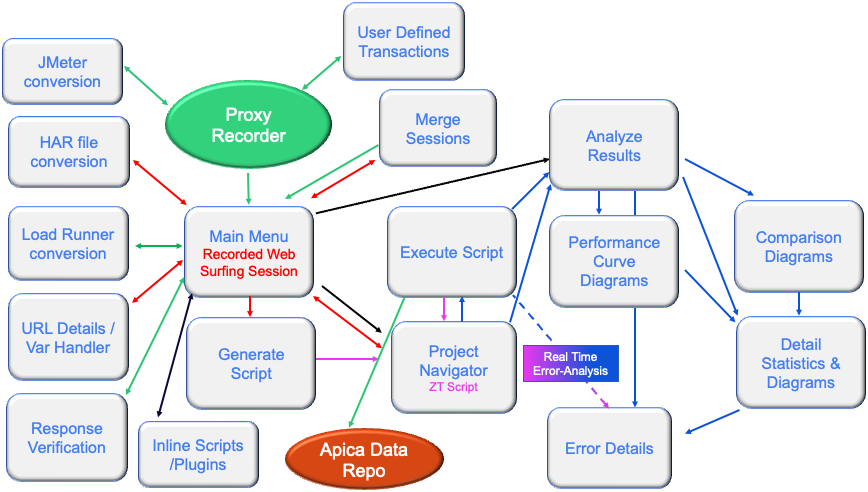...
You can use Apica ZebraTester standalone running in your infrastructure or with the Apica LoadTest Portal for the advanced team with continuous testing features.
...
Graphical User Interface
...
Apica ZebraTester™ ZebraTester contains a unique, powerful GUI which does not require you to learn any scripting language. In addition, no implementation of complicated regular expressions is required, even if you need to extract and assign user-specific dynamic session parameters or consider any other user-specific data such as authentication credentials.
...
Automatic generation of custom load test scripts – based on your click-by-click GUI actions.
Integrated wizards for extracting and assigning user-specific session parameters.
Integrated support of input files containing user-specific data.
Integrated support for user-specific execution control, response verification, and error actions.
Web Standards Support
ZebraTester supports these Web Standards
|
|
Authentication Methods
HTML Form-Based Login
Basic Authentication
Digest Authentication
NTLM Authentication - supports CyberArk password vault for dynamically fetching passwords
SSL Authentication using X509 Client Certificates in PKCS#12 format, DER or PEM encoded format
SSL Authentication using Smart Cards and HSMS (PKCS#11 security devices)
Kerberos with SPNEGO Authentication - supports CyberArk password vault for dynamically fetching passwords
Non-standardized authentication methods can be supported by developing your own “plug-ins.”
Proxy Recorder
The universal HTTP(S) proxy recorder supports capturing any web traffic produced from any web browser or produced from any technical web client application running on any computer, smartphone, or tablet.
...
The straight session can then be turned automatically into a ready-for-use load test script which can be executed directly as a customized load test.
Test Features
Configurable DNS servers, DNS cache, and DNS hosts file per executed load test
Configurable SSL/TLS settings per executed load test
Detailed real-time statistics
See all error details in real-time: Error analysis can be performed during a running load test.
Manually modify variable values and flow control in real-time
Real-time comments
Suspend and resume load test execution
Manually increase and decrease the number of simulated users in real-time
Conditional execution of web pages / URLs
Simulate slow network connections
Integrated scheduler
Concurrent test execution: Run multiple load tests at one time on the same infrastructure
Integrated overload detection of load generators
Support of multiple TCP/IP addresses per load generator
Clustering of load generators
Test Measurement Features
Sampling rates up to 100%
Store the complete data from every test.
Measures in-depth values for each HTTP(S) request
DNS resolve time
TCP/IP connect time
SSL handshake time
Request transmit time
Time to First Byte of the response header
Response header received time
Response content received time.
Measures internal statistics inside DNS, TCP/IP, SSL, and HTTP layers.
Examples
DNS resolve rate
Abbreviated SSL handshake rate
HTTP Keep-Alive efficiency
Inner throughput diagram of each received HTTP content response.
All measured errors contain snapshots of all of the current HTTP data
Request header
Request content
Response header
Response content.
All measured errors also contain layer-specific context information
Outbound TCP/IP address
Outbound TCP/IP port
SSL session ID
The layer-specific execution step of the failed HTTP(S) request.
Example: If an empty web page is returned, you can see clearly if a network problem causes this or is caused by an overload of the stressed web server.
Each measured error also contains a snapshot of
The actual values of all user-specific variables and a snapshot statistic about the activity of all other users at error time.
The measurements can be complemented with additional statistics from Apica Inside Agents, which can collect real-time performance information from multiple in-house sources.
Operating systems (OS performance data)
Databases
Network
System management frameworks
NMP
ARM
APIs
Application management modules
Test Automation
Automate both test creation (recording and post-processing of HTTP/S sessions) and even the test execution.
Test Creation
...
Automate by calling the REST-API of the proxy recorder and by triggering the execution of self-developed “recorder plug-ins.”
Test Execution
...
Automate by calling the “PrxJob” utility.
Up to 86 different commands can be used in a self-written shell or *.bat scripts to start and synchronize load test executions.
Clustering Load Generators
You can combine local, remote, or cloud-based load generators into clusters.
Almost infinitely scalable : More than 300 load generators can be combined to form a single cluster.
Each load generator can be a member of several clusters.
Apica supports multiple locations AND mixed operating systems.
Split user account credentials and X509 client certificates across cluster members.
Easy to use and easy to operate.
All measured data are merged into one single test result.
Reporting Features
Generate PDF reports from Load Test results.
Comments can complement each report.
Create your report templates with your corporate logos on the cover sheet.
Up to 24 different diagrams and statistic types are available for reports.
Compare the results of different test runs to verify the efficiency of any implemented tuning measures; also visualize the response time behavior and the stability of the stressed web application under different load conditions.
Load Test Plug-ins
Extend the functionality during load test execution by creating custom load test plug-ins.
...
Related Page: ZebraTester Plug-in Handbooks
Context-Sensitive Help
...
All views provide context-specific help text, available using the Help button
Open Context Help
...
Click the help button for contextual help from any page and a related page (in this example, a Generate Load Test Help Page) will pop-up.
...

